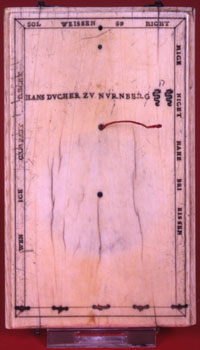Sundials in Poetry
 The motto around the edge of this sundial reads' Wen ich campast recht sol weissen so richt mich night bei eissen' (translation - 'if the compass is to show the way correctly, don't place it near iron'). This is a common motto on Nuremberg sundials, particularly those made by the Tucher family. This dial was made by Hans Tucher around 1600.
The motto around the edge of this sundial reads' Wen ich campast recht sol weissen so richt mich night bei eissen' (translation - 'if the compass is to show the way correctly, don't place it near iron'). This is a common motto on Nuremberg sundials, particularly those made by the Tucher family. This dial was made by Hans Tucher around 1600.
In the Shipman's Tale of the Canterbury Tales the narrator tells how a rich merchant is cheated by a monk, first by seducing the merchant's wife, and then by stealing his money. The monk invites the wife to dinner with the words, 'And lat us dyne as soone as that ye may; for by my chilyndre it is pryme of day'. The cylinder referred to is a pillar sundial, a form of altitude dial first made by the Romans and common among the merchant classes for many centuries.
In Act 2, scene VII of As You Like It, Jacques gives an account of his meeting with the fool. During this encounter the fool
drew a dial from his poke,It is not clear what sort of dial is meant in this passage, but it shows the commonplace nature of sundials during the Renaissance period.
and looking on it with lack-lustre eye,
says very wisely "It is ten o'clock"